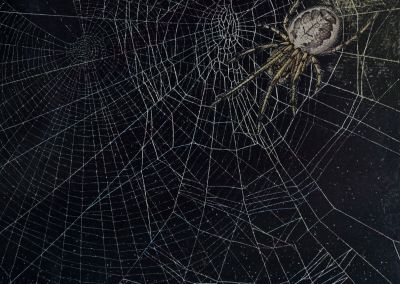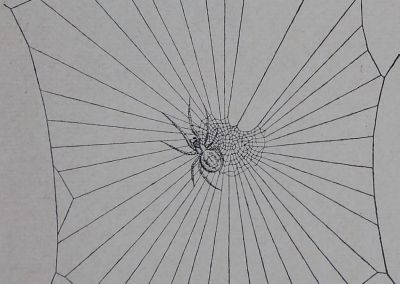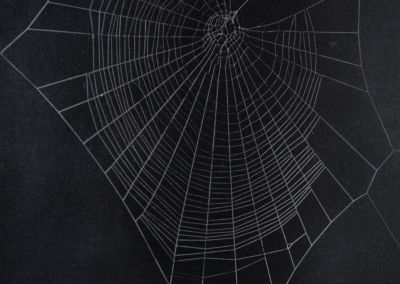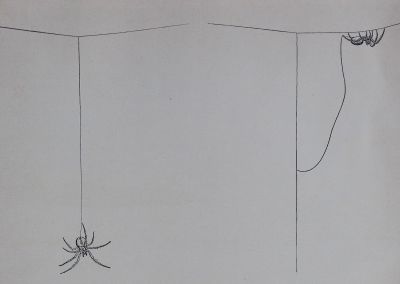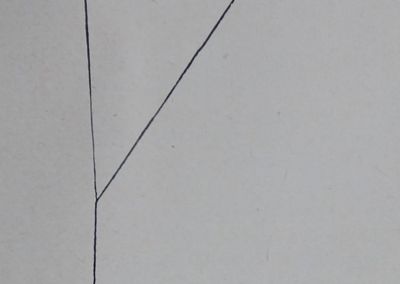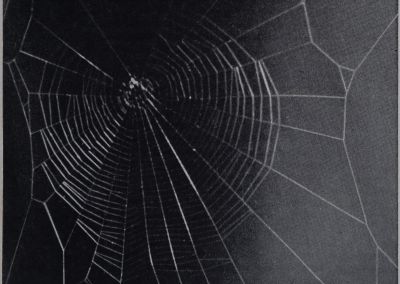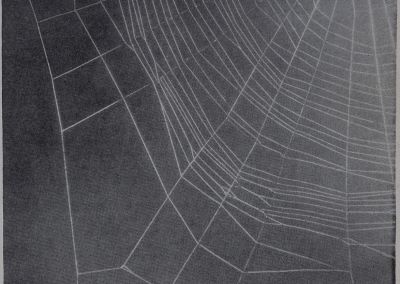Images Collection
Read OCR Digitized Article Text
NOTE: This plain text article interpretation has been digitally created by OCR software to estimate the article text, to help both users and search engines find relevant article content. To read the actual article text, view or download the PDF above.
Spider Webs and Drugs
The regularity of the delicate structures made by spiders is one of the wonders of nature. Now abnormalities in these patterns are used to study the mechanism by which drugs produce their effects
by Peter Witt
The members of the zoology department were dead tired. For days they had been trying to make a motion picture film of a spider building its web. Night after night they had waited up in the laboratory to catch their subject in its intricate construction job, but the perverse little creature had refused to perform for their cameras. Each morning they had fallen asleep
with exhaustion, only to find on awakening an hour or two later that the spider had spun a beautiful web during their sleep.
In desperation a delegation of the zoologists finally came to my pharmacology department (we were all colleagues at the ancient University of Tübingen in Germany). Could I supply them with a drug which would stimulate the dilatory spider to spin its web when they want- ed it to? As it happened, the zoologists found me in a mood of despair that matched their own. I had been experimenting with various drugs to try to find out whether they differed in their effects on human beings. My test drugs (marihuana, mescaline, morphine, scopolamine, Benzedrine ) had evoked wonderful responses in my subjects—fantastic dreams, weird visions in color, laughter, tears and all sorts of emotions. But the experiments had failed to yield any answer to my question about specific differences among the drugs.
Naturally I pointed out to the zoologists that I had not the slightest idea how the drugs would affect spiders. Nevertheless I gave them samples of several drugs to try.
The next morning my zoology friends returned with news which, though rather disappointing to them, was highly exciting to me: The drug they had administered to the spider had not accelerated its performance, but it had caused the animal to spin a web of a strange shape never seen before.
I at once decided to transfer my experiments from human beings to spiders. Human subjects are moody, complicated, variable and apt to carry over memories from one experiment to the next. Spiders promised to be much simpler subjects for testing the effects of drugs on the central nervous system. Furthermore, they might yield information which could be put to practical use. If spiders responded differently to different drugs, they would afford an easy test for identifying a small amount of an unknown drug—for instance, in cases of accidental or deliberate poisoning.
Fortunately Professor Hans M. Peters and his colleagues in the zoology department had given much study to the web-building of spiders, including the webs’ geometric shapes, and we joined efforts in what was to prove a fruitful collaboration.
To begin at the beginning, let us see why and how a spider builds its web. The spider we selected for our experiments is Zilla x-notata, which spins an orb web. To a spider the sense of touch is what the sense of sight is to man— its most important means of livelihood. Its web, of course, is its tool for catching food. The Zilla spider sits just off a corner of this structure with two forelegs resting on a “signal” thread running from the outer edge to the center of the web. The whole web can be looked upon as a projection of its legs, waiting tensely to communicate any vibration to the spider. The moment a fly’s vibrating wings touch the threads of the web, the spider pounces on it, paralyzes it with its poisonous bite and binds it with a sticky thread. Then it proceeds at leisure to suck the juices from its prey.
That touch rather than sight guides the spider was proved by an English amateur scientist who discovered that a tuning fork vibrating with the same frequency as a fly’s wings also provokes the spider’s assault; so will a vibrating dummy of a fly. On the other hand, if the signal thread is cut so that the spider cannot feel vibrations of the web, it will pay no attention to a fly crossing the web directly in front of it.
T f its web is destroyed day after day, the •*- spider will build a new web every day. Normally it spins each web in the same way and in the same pattern. It usually chooses a window or some other frame as the support. First it attaches an end of thread, which it secretes from its thread-forming gland, to one point on the frame; then it may move horizontally along the frame, paying out more thread and dragging it behind, until it has reached a second point a suitable dis
tance from the first. There it pulls the thread tight and fastens the end at the second point. Now it moves back along this “bridge” and spins a new thread perpendicularly from the middle of it, forming a T. Dangling by this thread, the spider steadily extends it by spinning more length until it reaches a fastening point. This completes the first stage of the web construction. The first stage may take any of several other forms, depending on the shape and nature of the site. But the following stages are always the same. The spider proceeds to spin radial spokes from the center to the outer framework of its web. If it has started with the T described above, it climbs back up the vertical member and along the arm of the T to its starting point, all the time letting out new thread. There it pulls the new thread tight across the diagonal of the triangle [see drawings above]. This forms a radial member of its web. In like manner the spider goes on spinning new bridges and radii until it has completed a peripheral frame connected to the center by many radial threads. The angle between these radii is remarkably uniform; most of the spac- ings do not vary by more than one or two degrees. However, the Zilla spider
leaves extra space around one spoke which will serve as the signal thread [see diagram on page 80].
Now the spider proceeds to build the cross members that connect the spokes. It does this by spinning a thread which starts near the outer frame and spirals in toward the center (after it has first laid a temporary thread across the spokes to hold them in position while it moves over them). For this so-called “catching spiral” the spider spins an especially delicate thread covered with a thin layer of sticky fluid. Zilla draws the spiral thread from spoke to spoke around the web until it reaches the one next to the signal thread; then it turns and goes back the other way, thus leaving a free sector around the signal thread. As it fills in its web, the spider measures the distance from thread to thread with its legs and probes the tension of the lines to make sure there will be no loopholes through which a fly may escape.
There are some mystifying features about the spider’s construction of its spiral. For instance, one would suppose that for the sake of efficiency the animal would begin by spacing the turns of the spiral close together near the periphery, where the radii are far apart, and would widen the interval between the turns as it moved toward the center. But the spider does exactly the opposite: it narrows the spaces between the spiral turns as it approaches the center. Possibly the reason for this strange behavior is a disposition to minimize the distance it must climb from spoke to spoke; however, there seem to be a great many factors involved in the spider’s construction of its spiral, and we have only begun to find them out. As will be seen, it is mainly in the spinning of the spiral that spiders show the effects of drugs.
We know that every species of spiderr makes its own kind of web, and that it builds its characteristic kind by instinct; when a baby spider spins its first web, even if it has never seen a web before it makes one just like its forebears’, except on a smaller scale. The drive to build a web is in direct proportion to the spider’s hunger. A hungry spider will spend enormous amounts of energy building webs day after day. In our experiments we keep the animals on a diet which is sufficient to keep them healthy and reasonably satisfied with their captivity but is spare enough to make them build a web every night. We use female spiders, because males, being only half the size of females and requiring less food, build webs much less often.
We chose Zilla as the test animal partly because this spider lives outside its web. It will adopt a paper bag as its home and thus is easy to keep captive. To capture a Zilla spider I bait it out of its hiding place in the garden or a window by touching its web with a tuning fork. While it is attacking the fork, I lay a paper bag on the signal thread. When the disappointed spider returns from its fruitless sally, it enters my paper bag without even noticing that its house has been changed. I can fasten the bag to the corner of a portable wooden frame, and thereafter the spider will build web after web on the frame, always returning to the bag as its home. A large array of such frames hangs in front of the enormous window of my laboratory. Each contains a spider.
A spider’s web, needless to say, is no easy thing to study. The threads are so thin and delicate that they can hardly be seen, and they break at the slightest touch of a clumsy human finger. Nor will a web keep for any length of time. Because the gossamer threads are difficult to photograph, even with the best modern camera, H. Homann in Germany conceived the excellent idea of thickening the threads by dusting them with a material that does not bother spiders. A glass bowl filled with a solution of ammonia gas in water and another bowl with a solution of hydrochloric acid are placed under the web. The rising vapors from the bowls combine in the air to form fine crystals of ammonium chloride. In 20 minutes the crystals have covered all the threads with a fine white layer, so light that it does not make the delicate filaments sag but thick enough to make every thread stand out clearly when the white-coated web is photographed against a black background with light from the side.
It is important to see every part of the web, for the changes induced by the drug experiments are subtle. The delicate pattern of the finished web is the result of a precise and complicated pattern of movements by the spider. When a spider’s central nervous system is drugged, it departs from this pattern, as a man intoxicated by alcohol weaves an erratic course down the street. The spider’s errant movements leave their telltale tracks in a distorted web. And we were delighted to discover that each drug always produced its own distinctive aberrations in the spider.
To administer drugs to spiders without alarming them took a little doing. After many experiments, one of our medical students, Dieter Wolff, found a convenient way. A fluid containing the drug, sweetened with sugar to conceal the drug’s taste, is injected into the hind part of a fly, where the spider is accustomed to tap the juices. The fly is cut in half, but the spider is lured to it by a tuning fork simulating the vibrations of its wings. Spiders apparently find the taste of the sugar delicious, for they have taken every drug offered in this way.
When we began to test the effects of drugs, one of the first things we noticed was that a spider made drowsy by a sleeping drug would skip the spinning of the longest and most difficult radial threads—those to the corners of the frame. This left conspicuous gaps in its web [see photograph on page 81].
Of the many other effects, most of which we cannot yet even begin to interpret, I shall mention three which seem especially significant. Benzedrine causes the Zilla spider to spin a spiral which has the usual over-all shape but tends to zigzag like an unsteady walker [see photograph on page 86], We strongly suspect that under the influence of Benzedrine the spider loses its ability to locate precisely the points at which it should fix its spiral. Marihuana, in contrast, produces no disturbance of the sense of direction, but it does cause the spider to omit the first part of the spiral: the animal starts closer to the center and leaves the outer part of the web uncovered by cross members [see photograph at left]. This effect is peculiar to marihuana—it is always produced by that drug, and only by that drug, as far as I know.
The third drug of special interest is scopolamine, which in human beings produces hallucinations and strange disorientations. Scopolamine destroys a spider’s sense of direction almost completely. Its spiral no longer takes regular turns around the center but may go off in false directions.
How far can the effects on spiders be compared to effects of the same substances on human beings? This question will never be answered fully, as we cannot interview a spider to find out what it feels and experiences. We can only compare superficially some of the known facts. It is likely that a general disturbance of the functions of the brain shows its effect in distortion of the sensitivity of touch in the spider, as it distorts vision in man. The strange and colorful visual hallucinations that a man experiences under mescaline may take the shape of haptic (touch) hallucinations in the spider. Yet the general course of an intoxication may be alike in both; for instance, the effect may come and
go in waves. This is the way scopolamine affects man, and such a rhythm may be responsible for the fact that a spider under the same influence periodically loses and regains the correct direction in building a spiral. But these are mere speculations.
“WThy should we work with that ™ strange animal, the spider, instead of some familiar higher animal more like man? The answer is that we cannot interview higher animals about their experiences any more than we can spiders, but the little spider gives us every day in its web an objective and measurable report on the state of its health and its nerves. When we have learned how to interpret it, we shall be able to read a most interesting story in that precise and complicated structure.
